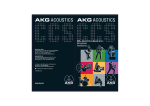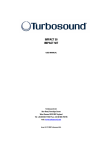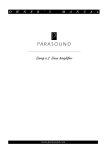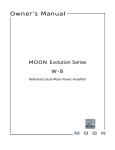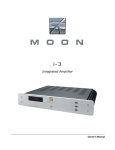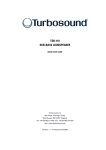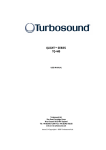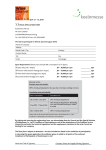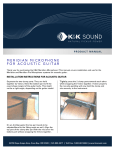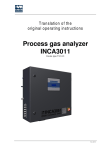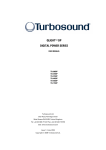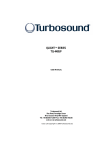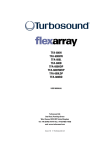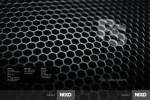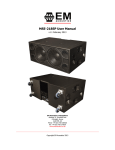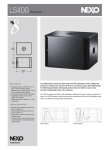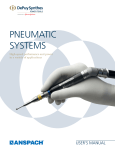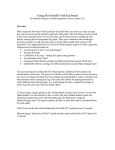Download TFS-780 - Noretron Audio
Transcript
datasheet F L A S H L I G H T ® S E R I E S E N G I N E E R I N G I N F O R M AT I O N The Flashlight TFS-780 System is a fully integrated long loudspeaker and covers the frequency range throw sound reinforcement system in an extremely compact between 150Hz and 1k3Hz. The smaller TurboMid™ and manageable form. It is supplied as a system package device is fitted with an intensively developed 6.5" comprising loudspeaker enclosures; amplifier racks; a cone loudspeaker covering the frequency range system controller and all the requisite cables and between 1k3Hz and 8kHz. This combination of connectors. This combination of components is configured TurboMid™ devices represents an unprecedented as the ideal "building block" for the creation of spherical step in the use of cone-type transducers up to 8kHz, arrays, providing a formidable system for large arena use. resulting in increased reliability and power handling The Flashlight system is easily capable of delivering full and a startling improvement in acoustic clarity and range (30 - 20kHz), very low distortion, coherent sound in the detail over any compression driver working in the biggest indoor or outdoor venues. same band. This leaves the remaining frequencies The TFS-780H uses very narrow dispersion pattern components. These are further developments of (8kHz - 20kHz) to be easily handled by a custom 1” (25mm) compression driver. Turbosound's Proportional Directivity™ in a very All the units in the TFS-780H are correctly time- high-Q enclosure and enables seamless coverage aligned within the system controller, which is pre- over a massive area with anything from 1/2 to 1/4 set during manufacture. In addition, user- the number of conventional enclosures, depending controllable time alignment adjustment on the distance from the array. In reality this also compensates for the physical displacement of means that many applications that would normally the bass devices with respect to the mid-high require distributed delays will no longer need them. enclosures. The combination of the amplifier The loudspeakers are divided into two uniformly sized enclosures: the TFS-780L and the TFS-780H. The TFS-780L covers the low frequencies in the power, coupled with very high efficiency drivers equates to considerable sound pressure levels being achieved with exceptional clarity. range 30 - 150Hz and contains a 21" loudspeaker The control system comprises a digital crossover with a 6" voice coil, loaded with a TurboBass™ with factory-loaded crossover programs, high device. The TFS-780H consists of two specially performance limiters, electronically balanced inputs developed long-throw TurboMid™ devices, and a and outputs and an auto-switching high-Q 25mm (1") waveguide horn. The larger power supply. TurboMid™ device is driven by a very powerful 12" TFS-780 The power amplifiers are designed specifically for use with the Flashlight system. They are capable of delivering the high power level demands that the loudspeaker system is capable of converting into acoustic energy. The amplifiers are supplied in a 19" rack unit in groups of four, complete with all the necessary wiring and multi-pin connectors. To take full advantage of such a highly tuned FEATURES Total system optimisation system, with such accurately defined dispersion Negligible harmonic characteristics, Turbosound's engineers have distortion developed a safe, flexible and ingeniously simple flying and lifting system. This allows the creation of Proportional directivity clusters and arrays with full control of the angular inclinations between adjacent enclosures to suit a variety of requirements. APPLICATIONS Stadium and arena installation Touring and festivals datasheet TFS-780H DIMENSIONS (HXWXD) NET WEIGHT COMPONENTS F L A S H L I G H T ® S E R I E S E N G I N E E R I N G I N F O R M AT I O N 825mm x 574mm x 773mm (32.5” x 22.6" x 30.4") 87kg (191 lbs) 1 x 12” (305mm) LMF driver, 1 x 6.5” (165mm) HMF driver, 1 x 1” (25mm) HF compression driver FREQUENCY RESPONSE1 150Hz – 20kHz ±4dB NOMINAL DISPERSION2 25°H x 25°V @ -6dB points POWER HANDLING LMF: 250 watts r.m.s., 500 watts program, 625 watts peak HMF: 100 watts r.m.s., 200 watts program, 250 watts peak HF: 25 watts r.m.s., 50 watts program, 65 watts peak SENSITIVITY3 MAXIMUM SPL CROSSOVER LMF: 107dB, 1 watt @ 1metre; HMF: 111dB, 1 watt @ 1metre; HF: 110dB, 1 watt @ 1 metre 136dB continuous4, 142dB peak5 Active LMF/HMF: 1k3Hz, 24dB/octave, Linkwitz-Riley HMF/HF: 8kHz, 24dB/octave, Linkwitz-Riley NOMINAL IMPEDANCE CONSTRUCTION LMF: 8 ohms, HMF: 16 ohms, HF: 16 ohms 18mm (3/4”) birch plywood throughout; rebated, screwed and glued. Finished in TurboBlue™ semi-matt textured paint. Eight recessed carrying handles. Detachable wheel board GRILLE CONNECTORS OPTIONS SPARES AND ACCESSORIES Cloth/expanded metal (2) 6-pin EP6 wired; pin1 LMF-; pin2 LMF+; pin3 HMF-; pin4 HMF+; pin5 HF-; pin6 HF+ Flying System – refer to the “Flying and Lifting” section LS-1203 1 x 12” (305mm) LMF loudspeaker LS-6501 1 x 6.5” (165mm) HMF loudspeaker CD-103 1 x 1” (25mm) HF compression driver RC-1203 Recone kit for LS-1203 RD-6501 Recone kit for LS-6501 RD-103 Replacement diaphragm for CD-103 MG-780 Replacement cloth/expanded metal grille PX-780 Internal passive HF filter W-3 Heavy duty wheel Notes 1 Measured on axis 2 Average over stated bandwidth 3 Average over stated bandwidth 4 Unweighted diode-clipped pink noise. Measured in a half space environment. 5 Verified by subjective listening tests of familiar program material, before the onset of perceived signal degradation. page 2 datasheet F L A S H L I G H T ® S E R I E S E N G I N E E R I N G I N F O R M AT I O N 825mm x 574mm x 773mm (32.5” x 22.6" x 30.4") 90 kg (198 lbs) 1 x 21” (533mm) LF driver on a TurboBass™ device 50Hz – 150Hz ±4dB 600 watts r.m.s., 1200 watts program, 1500 watts peak 101dB 1 watt @ 1metre 131dB continuous3, 136dB peak4 8 ohms 18mm (3/4” birch plywood throughout; rebated, screwed and glued. Finished in TurboBlue™ TFS-780L DIMENSIONS (HXWXD) NET WEIGHT COMPONENTS FREQUENCY RESPONSE1 POWER HANDLING SENSITIVITY2 MAXIMUM SPL NOMINAL IMPEDANCE CONSTRUCTION semi-matt textured pain. Four recessed carrying handles Cloth/expanded metal (2) XLR-3 wired: pin 1-; pin 2+ Flying System – refer to the “Flying and Lifting” section LS-2101 1 x 21” (533mm) LF loudspeaker RC-2101 Recone kit for LS-2101 MG-780 Replacement cloth/expanded metal grille W-3 GRILLE CONNECTORS OPTIONS SPARES AND ACCESSORIES Heavy duty wheel Notes Measured on axis 2 Average over stated bandwidth 3 Unweighted diode-clipped pink noise. Measured in a half space environment. 4 Verified by subjective listening tests of familiar program material, before the onset of perceived signal degradation 1 page 3 datasheet TFS-780 F L A S H L I G H T ® S E R I E S E N G I N E E R I N G I N F O R M AT I O N Sound Pressure Level in dB 120 FREQUENCY RESPONSE SYSTEM 110 100 90 80 70 20 Hz 50 100 200 500 1 kHz 2 5 10 20 Frequency TFS-780L LOW FREQUENCY TFS-780H LOW-MID FREQUENCY 130 Ref. Fundamental 10% Power 110 120 Sound Pressure Level in dB 120 Sensitivity 1W/1M 90 80 1.0% 2nd Harmonic 10% Power 3rd Harmonic 10% Power Sensitivity 1W/1M 100 90 1.0% 80 70 2nd Harmonic 10% Power 3rd Harmonic 10% Power 0.2% 60 100 200 500 1 kHz 2 5 0.1% 20 Hz 50 10 20 100 200 Frequency 5 10 20 TFS-780H LOW-MID FREQUENCY 300 200 300 200 100 100 Ohms Ohms 500 1 kHz 2 Frequency TFS-780L LOW FREQUENCY 16 10 8 16 10 8 4 4 2 2 1 1 20 Hz 50 100 200 500 1 kHz2 Frequency page 4 0.2% 60 20 Hz 50 NOTES ON MEASUREMENT CONDITIONS Distortion % 100 70 IMPEDANCE Ref. Fundamental 10% Power 110 Distortion % Sound Pressure Level in dB 130 5 10 20 20 Hz 50 100 200 500 1 kHz2 5 10 20 Frequency Impedance A common method, constant current circuit was use to measure the impedance. Frequency Response The frequency response shown was obtained by feeding a swept sine wave through the system in a half-space environment. The position of the microphone was vertically on-axis, horizontally in-line with the MF/HF section at a distance of 3 metres, then scaled to represent 1 metre. 2nd & 3rd Harmonic Distortion Distortion measurements were obtained using an Audio Precision harmonic distortion analysis system and comply with AES recommendations for enclosure measurement (AES Paper reference: ANSI S4-26-1984). Data Conversion All graphs were digitally generated using the APEX custom software system, designed to translate data derived from Brüel & Kjæl and Audio Precision “System One” test equipment into AutoCAD™. This program enables graphical information to be plotted to an accuracy of more than four decimal places. datasheet F L A S H L I G H T ® S E R I E S E N G I N E E R I N G I N F O R M AT I O N TFS-780H HIGH-MID FREQUENCY TFS-780H HIGH FREQUENCY 110 90 70 1.0% 2nd Harmonic 10% Power 3rd Harmonic 10% Power 120 Fundamental 10% Power Ref. 110 Distortion % Sensitivity 1W/1M Sound Pressure Level in dB Fundamental 10% Power Distortion % Sound Pressure Level in dB Ref. 120 80 FREQUENCY RESPONSE 130 130 100 TFS-780 Sensitivity 1W/1M 100 90 80 70 2nd Harmonic 10% Power 3rd Harmonic 10% Power 1.0% 0.2% 60 0.1% 60 20 Hz 50 100 200 500 1 kHz2 5 10 20 0.2% 20 Hz 50 100 200 Frequency 5 10 20 Frequency TFS-780H HIGH FREQUENCY TFS-780H HIGH-MID FREQUENCY 300 200 300 200 100 100 Ohms Ohms 500 1 kHz2 16 10 8 16 10 8 4 4 2 2 1 IMPEDANCE 1 20 Hz 50 100 200 500 1 kHz2 Frequency 5 10 20 20 Hz 50 100 200 500 1 kHz2 5 10 20 Frequency Impedance A common method, constant current circuit was use to measure the impedance. Frequency Response The frequency response shown was obtained by feeding a swept sine wave through the system in a half-space environment. The position of the microphone was vertically on-axis, horizontally in-line with the MF/HF section at a distance of 3 metres, then scaled to represent 1 metre. 2nd & 3rd Harmonic Distortion Distortion measurements were obtained using an Audio Precision harmonic distortion analysis system and comply with AES recommendations for enclosure measurement (AES Paper reference: ANSI S4-26-1984). Data Conversion All graphs were digitally generated using the APEX custom software system, designed to translate data derived from Brüel & Kjæl and Audio Precision “System One” test equipment into AutoCAD™. This program enables graphical information to be plotted to an accuracy of more than four decimal places. NOTES ON MEASUREMENT CONDITIONS page 5 datasheet TFS-780 DIRECTIVITY ISOBARS F L A S H L I G H T ® S E R I E S E N G I N E E R I N G I N F O R M AT I O N 500 Hz 1 kHz MF MF -3dB -12dB -9dB -6dB -3dB 20° 40° 60° 80° 100° 120° 2 kHz 4 kHz MF HF -15dB -12dB -9dB -6dB -3dB 20° 40° 60° 80° 100° 120° 8 kHz 16 kHz MF HF -3dB -15dB page 6 40° 60° 80° 100° 120° -15dB -12dB -9dB -6dB -3dB 20° 40° 60° 80° 100° 120° 40° 60° 80° 100° 120° -3dB 20° TURBOSOUND ISOBAR DATA 20° 40° 60° 80° 100° 120° 20° -15dB The spherical co-ordinate isobar data was computed from points taken from longitude and latitude polar measurements around the enclosure at 10° increments. Larger scale drawings are available; please consult your dealer. All isobar information was gathered by Turbosound Research & Development, England. datasheet F L A S H L I G H T ® S E R I E S E N G I N E E R I N G I N F O R M AT I O N HORIZONTAL 0° 0° 30 10 90° 0° 0° 30 40 12 21 0° 180° 20 0° 15 0° 15 10 0° 24 12 0 180° 40 21 0° 40 30 30 20 20 10 24 10 0 0° 10 270° 0 10 90° ° 60 40 0° ° 30 60 20 30 ° 0° 33 30 ° 0° 33 0° 10 DIRECTIVITY ISOBARS VERTICAL 30 10 270° 0 BEAMWIDTH 360 300 Degrees between -6dB points TFS-780 200 100 90 80 70 60 50 40 30 20 Horizontal Vertical 10 20 Hz 50 100 200 500 1 kHz 2 5 10 20 Frequency 24 200 100 18 50 15 20 12 10 9 5 6 3 2 0 1 20 Hz 50 100 200 500 1 kHz 2 5 10 DIRECTIVITY Directivity Factor Q Directivity Index dB 21 20 Frequency All the polar measurements were taken using Audio Precision and MLSSA test equipment, with a microphone placed at a distance of 4 metres from the rotational axis of the loudspeaker enclosure under test. This method reduces the effect that the interaction between the MF and HF has on the measurements. For clarity, the polar information is displayed with progressively thinner lines from 250Hz to 16kHz in third octave steps. The beam-width plots were computed from the third octave polars. The enclosures were measured in a half space environment. All polar information was gathered by Turbosound Research & Development, England. All graphs are digitally generated using the APEX custom software system, designed to translate data derived from Brüel & Kjær and Audio Precision “System One” test equipment into AutoCAD™. This program enables graphical information to be plotted to an accuracy of more than four decimal places. NOTES ON MEASUREMENT CONDITIONS page 7 datasheet TFS-780 SYSTEM MANAGEMENT OVERVIEW F L A S H L I G H T ® S E R I E S E N G I N E E R I N G I N F O R M AT I O N A dedicated series of components provides amplification, system management and control for the Flashlight loudspeaker enclosures. The system accepts line level input signals, and takes care of all aspects of signal conditioning up to the loudspeaker input connectors. Flying Flying bar Bar Flying Flying Barbar Stereo in Stereo In Left and Right Left & Right System System Controller Controller Amp Amp Rack Rack page 8 Amp Amp Rack Rack datasheet F L A S H L I G H T ® S E R I E S E N G I N E E R I N G I N F O R M AT I O N The LMS-D6 digital loudspeaker management system consists of two inputs and six outputs configured for control of all the signal, phase and time parameters required to operate the TFS-780 SYSTEM MANAGEMENT loudspeaker enclosures effectively. It comprises 24dB per octave Linkwitz-Riley crossovers, high performance limiters, variable delays, electronically balanced inputs and outputs, and a switching power supply that automatically adjusts to mains input voltages between 90 volts and 260 volts. It is supplied as a 1U high unit and has adjustable controls for time compensation when the TFS-780L bass enclosures are displaced relative to the TFS-780H mid-high enclosures. Two LMS-D6 controllers are required for a Flashlight system. No other signal conditioning or processing is necessary and the unit is supplied factory aligned, tested and ready for use. LMS-D6 < BACK NEXT> MENU ENTER FREQ 'Q' GAIN A B 1 CLIP BYPASS O MAINS IN ~ 90V - 240V AC 50 - 60Hz 30W POWER RS232 DATA INPUT CAUTION! FOR CONTINUED PROTECTION AGAINST FIRE REPLACE ONLY WITH THE SAME TYPE T1A, 250V FUSE 4 3 LIM LIM 5 LIM 6 LIM -3 -3 -3 -3 -3 -24 MUTE -24 MUTE -24 MUTE -24 MUTE -24 MUTE -24 MUTE LMS-D6 FLASHLIGHT SYSTEM CONTROLLER OUT DIGITAL LOUDSPEAKER MANAGEMENT SYSTEM I 2 LIM -6 GAIN OUTPUT 6 WARNING / AVIS OUTPUT 5 GAIN GAIN OUTPUT 4 OUTPUT 3 GAIN GAIN OUTPUT 2 GAIN OUTPUT 1 GAIN GAIN INPUT B INPUT A PUSH PUSH DO NOT EXPOSE TO RAIN OR MOISTURE THIS EQUIPMENT MUST BE EARTHED SHOCK HAZARD - DO NOT REMOVE COVERS RISQUE DE CHOC ELECTRIQUE - NE PAS OUVRIR PIN1=SHIELD PIN2=HOT PIN3=COLD CUSTOM MADE FOR TURBOSOUND IN THE UK BY XTA ELECTRONICS LMS-D6 TECHNICAL SPECIFICATIONS 44mm x 482mm x 300mm (1.75” x 19" x 11.8") 3.5 kg (7.5 lbs) 2 inputs, 6 outputs ±0.5dB, 20Hz - 20kHz >110dB, 20Hz - 20kHz Unwtd. <0.02% @ 1kHz, + 18dBu 10k ohms, electronically balanced AC Mains 50/60Hz, 60V or250V ±15% <20 watts (2) XLR 3 - 31 (3 pin female XLR type) adjustable +15dB to -40dB in 0.1dB steps Electronically balanced (6) XLR 3 - 32 (3 pin male XLR type) +20Bm into 600 ohms DIMENSIONS (HXWXD) NET WEIGHT CROSSOVER TYPE FREQUENCY RESPONSE DYNAMIC RANGE DISTORTION (THD) INPUTS POWER SUPPLY POWER CONSUMPTION INPUT CONNECTORS INPUT GAIN OUTPUTS OUTPUT CONNECTORS MAXIMUM OUTPUT LEVEL page 9 datasheet TFS-780 SYSTEM AMPLIFICATION RACK F L A S H L I G H T ® S E R I E S E N G I N E E R I N G I N F O R M AT I O N The Turbosound Flashlight System has been designed in conjunction with state-of-the-art power amplifiers. Four power amplifiers are supplied, housed in a 12U, steel spaceframe equipment rack. The standard configuration is: 2 x TMC-750 amplifiers (for high and highmid), and 2 x TMC-1250 amplifiers (for low-mid and low). The power amplifiers occupy 10U of the total space available, 2U being devoted to incoming AC power distribution and multiway signal and speaker connections. Removal of a bridging plug at the rear of the connector panel allows the rack to be used in two channel (stereo) mode. Remote control cards are fitted to each amplifier, enabling digital remote control and monitoring of Flashlight systems. The mains connection panel comprises a ‘Wago’ mains distribution block, mounted on a fully enclosed steel panel, with a captive cable fitted with a ‘C-form’ heavy duty mains connector. The system can be configured for either a single or three phase star supply. This will suit the majority of contemporary connection methods for both 110/120 volt and 220/240 volt mains. Audio connections are made with the superb 12 pin Lemo video-type multi-connectors for line level inputs, and 19 pin 20A screw lock multi-connectors to carry the high level output signals. The rack is supplied with two 4 metre fan-outs; one multi-way to XLR for TFS-780L enclosures, and one multi-way to EP6 for TFS-780H enclosures. A 2.5 metre Lemo to Lemo signal cable is supplied with each rack for interconnection; custom stage return systems can be supplied to specific customer requirements. Socapex 19 way 2.5mm multi-core speaker extensions are optionally available in 12.5 metre or 25 metre lengths for flown speaker enclosures. Two 3-pin XLR connectors are provided for remote control input and link. The complete equipment rack is identical to previous BSS-equipped racks and is housed in a heavy duty road case with wheels and snap-back handles. CE certified racks are available for those countries where certification is required. BOTH CHANNELS. SIGNAL CH1 -3 -6 -9 Temp. BOTH CHANNELS. CH1 INPUT OR LINK -6 -9 Fault HIGH OUTPUTS 0 dB Limit -3 -12 CH1 CH2 Ch.B 0 dB 2 ohm CH2 LOW OUTPUTS CH2 Ch.A Fault -15 Bridged -12 -15 -20 -20 -25 -25 Mute Mute Link REMOTE CONTROL DATA POWER INPUT AND LINK Ch.A 0 dB 0 dB Limit -3 -3 -6 2 ohm AMP-780.2 Ch.B -6 -9 -12 -9 Fault Temp. Fault -15 Bridged -12 -15 -20 -20 -25 -25 Mute Link Mute POWER Ch.A Ch.B 0 dB 0 dB Limit -3 Low Z -3 -6 -9 -6 Fault Temp. Fault -15 Mute Bridged -9 -15 -25 -25 Link Mute POWER Ch.A Ch.B 0 dB 0 dB Limit -3 Low Z -3 -6 -9 -6 Fault Temp. -15 Mute -25 Fault Bridged -9 -15 Link -25 Mute POWER REAR FRONT AMP-780.2 SPECIFICATIONS DIMENSIONS (HXWXD) (IN ROAD CASE) NET WEIGHT DIMENSIONS (HXWXD) (EXCL. ROAD CASE) NET WEIGHT page 10 800mm x 570mm x 820mm (31.5” x 22.4" x 33.3") 196 kg (431 lbs) 590mm x 512mm x 693mm (23.2” x 20.2” x 27.3”) 152kg (334 lbs) datasheet F L A S H L I G H T ® S E R I E S E N G I N E E R I N G I N F O R M AT I O N TFS-780 POWER AMPLIFIERS Ch.A Ch.B 0 dB 0 dB Limit -3 Low Z -3 -6 -9 -6 Fault Temp. Fault -15 Mute Bridged -9 -15 Link -25 -25 Mute POWER TMC-750 Ch.A Ch.B 0 dB 0 dB Limit -3 Low Z -3 -6 -9 -6 Fault Temp. -15 Mute -25 Fault Bridged -9 -15 Link -25 Mute POWER TMC-1250 TMC-750 88mm x 480mm x 410mm (3.5” x 19" x 16") 22 kg (48.4 lbs) Into 8 ohms: 425w/channel; Into 4 ohms: 750w/channel; Into 2 ohms: 750w/channel >90dB, 20Hz - 20kHz Unmeasureable <-105dB relative to full output >0.1%, 20 - 20kHz at any level below clip. Typically 0.01% 230V AC @ 10A max. or 120V AC @ 20A max DIMENSIONS (HXWXD) NET WEIGHT POWER OUTPUT CMRR CROSSTALK NOISE DISTORTION POWER REQUIREMENTS TMC-1250 130mm x 480mm x 460mm (5.1” x 19" x 18.1") 32 kg (70.4 lbs) Into 4 ohms: 1250w/channel; Into 2 ohms: 1800w/channel >80dB, 20Hz - 2kHz Unmeasureable <-105dB relative to full output >0.3%, 20 - 20kHz at any level below clip 230V AC @ 20A max. or 120V AC @ 35A max DIMENSIONS (HXWXD) NET WEIGHT POWER OUTPUT CMRR CROSSTALK NOISE DISTORTION POWER REQUIREMENTS page 11 datasheet TFS-780 FLYING AND LIFTING HARDWARE F L A S H L I G H T ® S E R I E S E N G I N E E R I N G I N F O R M AT I O N The Flashlight System may be supplied with a purpose designed lifting system which allows a wide range of adjustment to the horizontal and vertical angles between adjacent enclosures. The overall inclination between of each vertical column is also adjustable. Thus arrays can easily be achieved to suit a multitude of coverage requirements and allow the user to take advantage of the Proportional Directivity™ characteristics of the TFS-780H enclosures. Sound radiating from adjacent enclosures will successfully blend over a wide range of included angles, resulting in the ability to tailor not only the overall coverage, but also desired SPL at a distance. Most of the above adjustments may be made while the system is in the air and, because of the ingenious design of the flying hardware, the system will always remain in perfect physical balance. Horizontal adjustment is in 5° increments from 0° (transit position) to 30°, by swivel, locked by a spring loaded pin. Vertical adjustment between enclosures is from approximately 2° to 20° using the shortening hooks fitted to every enclosure’s suspension chains. Vertical inclination of each column is continuously adjustable over an arc of approximately 45°; this will ultimately depend on the number of enclosures in a column, and is achieved with a ratchet strap. It is envisaged that this function may be motorised, and remote controlled to compensate for changes in atmospheric conditions. The TFS-780H and TFS-780L both fly with the same vertical orientation; in many situations it may be desirable to stack the low frequency enclosures on their sides. page 12 datasheet F L A S H L I G H T ® S E R I E S E N G I N E E R I N G I N F O R M AT I O N Lifting point FB-780A MAIN BAR Safety point To suspend four columns of Flashlight enclosures with indexed horizontal adjustment TS-780 TILTING STRAP One pair required for each enclosure to be flown. One required for each column of enclosures Lifting eye Safety fixing FLYING AND LIFTING HARDWARE FC-780 FLYING CHAINS Tilting strap point Flying chain suspension point TFS-780 (These are handed left and right, the left ones have RED shortening hooks, the right ones BLUE shortening hooks) FB-780/TB TWIN BAR To suspend two columns of Flashlight enclosures with indexed horizontal adjustment SWL 1t Twin bars are handed and shouldbe ordered in pairs. They may then be converted into Main Bar Assemblies at a later date Tilting strap point Flying chain suspension point Lifting eye Safety fixing SWL 1t SINGLE BAR To suspend one column of Flashlight page 13 datasheet TFS-780 F L A S H L I G H T ® S E R I E S E N G I N E E R I N G I N F O R M AT I O N FT-780 FLY BAR TRUNK A purpose designed fly bar trunk is optionally available, which is used to house and transport a single FB-780A main fly bar assembly reliably and safely. Space is also provided for stowing flying chain assemblies and tilt straps within compartments in the trunk, thereby allowing all the hardware necessary to fly a 4-wide Flashlight cluster to be transported in a single road case. The FT-780 is supplied complete with heavy duty wheels and recessed handles, and is finished in TurboBlue™ semi-matt paint. 1660mm [65.4"] 580mm [22.8"] 810mm [31.9"] DIMENSIONS RT-8WAY & RT-16 WAY RETURNS SYSTEMS The Flashlight System may also be supplied with a custom returns cabling system to facilitate fast and reliable set-up and connections between system controller and amplifier racks, available in either 8-way or 16-way returns systems. The RT-8WAY comprises to channels of 4-way signal connections, and consists of 100 metres of high quality signal returns cable with lemo connectors, two 25 metre cross-stage lemo cables and an XLR break-out panel, all housed in a rugged road case. The RT-16WAY comprises four channels of 4-way signal connections, a 100 metre lemo return cable, four 25 metre cross-stage lemo cables and an XLR break-out panel in a road case. The XLR break-out panel connects the LMS-700 controller (normally located at the main mix position) outputs to the multi-way lemo cable which feeds audio signal to the on-stage amplifier racks. page 14 datasheet F L A S H L I G H T ® S E R I E S E N G I N E E R I N G I N F O R M AT I O N TFS-780H 773mm [30.4"] 574mm [22.6"] 773mm [30.4"] DIMENSIONS 825mm [32.5"] 955mm [38.0"] 825mm [32.5"] 574mm [22.6"] TFS-780 898mm [35.4"] page 15 datasheet TFS-780 ARCHITECTURAL & ENGINEER’S SPECIFICATIONS F L A S H L I G H T ® S E R I E S E N G I N E E R I N G I N F O R M AT I O N The loudspeaker system shall be of the quad-amped, four-way active type comprising: two loudspeaker enclosures loaded with patented TurboMid™ and TurboBass™ devices, high power stereo power amplifiers mounted in a 19” equipment rack sleeve and a system controller. All necessary system cables and connectors shall be included in the system. Performance specifications of a typical production unit shall meet or exceed the following:Frequency response, measured with a swept sine wave input shall be flat within ±4dB from 50Hz to 20kHz. Dispersion, at -6dB points, shall average 25°H x 25°V. Total power handling shall be 975 watts r.m.s., 1950 watts program, 2450 watts peak. Sensitivity measured with 1 watt input at 1 metre distance on axis, mean averaged between 1kHz – 18kHz shall be 111dB. Maximum SPL (peak), measured with music program shall be 142dB. System component dimensions shall be as follows:TFS-780H: 825mmH x 574mmW x 773mmD (32.5” x 22.6" x 30.4") TFS-780L: 825mmH x 574mmW x 773mmD (32.5” x 22.6" x 30.4") AMP-780.2: 800mmH x 570mmW x 820mmD (31.5” x 22.4" x 32.3") LMS-D6: 44mmH x 482mmW x 300mmD (1.75” x 19" x 11.8") Total enclosure volume shall not exceed 0.366 cu. metres (12.9 cu ft) for the TFS-780H and TFS-780L. The loudspeaker system shall be the Turbosound Flashlight System. No other system shall be acceptable unless the above combined performance specifications are equalled or exceeded. Flying and installation hardware shall be available comprising a range of load-certified components. TFS-780 Version 1.2 10/99 © Turbosound 1999 TURBOSOUND Ltd Star Road Partridge Green West Sussex RH13 8RY England tel: +44 (0) 1403 711447 fax: +44 (0) 1403 710155 • www.turbosound.com • e-mail: [email protected]
















